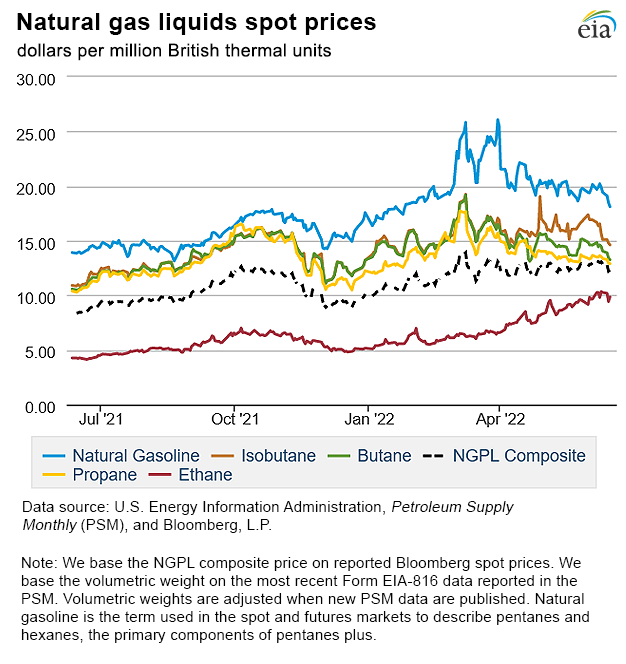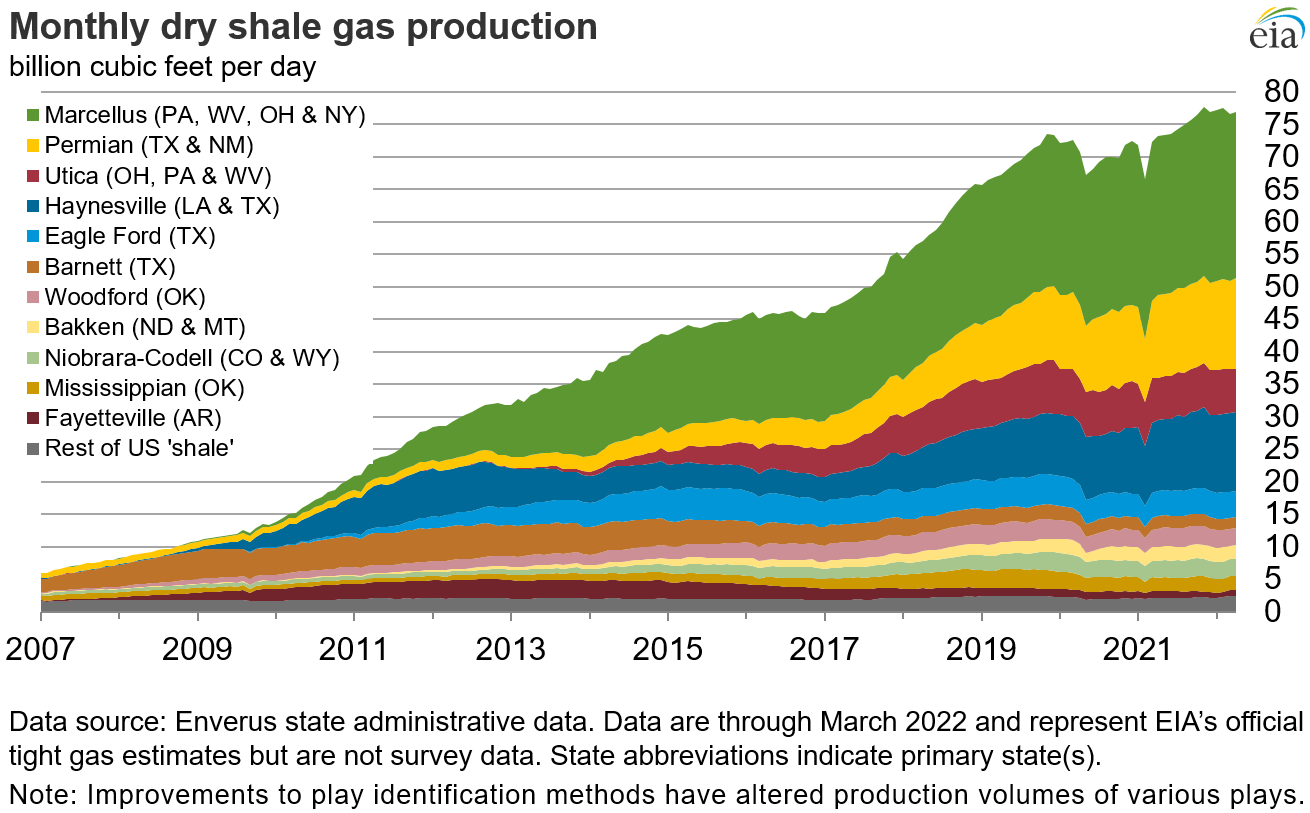In the News:
Fire causes shutdown of Freeport LNG export terminal
A fire at Freeport LNG‘s natural gas liquefaction plant in South Texas on June 8, 2022, has led to the full shutdown of the facility. The shutdown of the Freeport LNG facility, located south of Houston on the Gulf Coast, will reduce total U.S. liquefied natural gas (LNG) export capacity by approximately 2 billion cubic feet per day (Bcf/d), or 17% of the total U.S. LNG export capacity.
According to Freeport LNG Development, L.P., preliminary observations suggest that the fire was caused by excess pressure in an LNG transfer line that transfers LNG from the facility’s storage tank to the terminal’s dock facilities. The fire did not affect the main facilities, such as liquefaction trains, LNG storage tanks, dock facilities, and LNG process areas. The company announced that the terminal is not expected to return to full service until late 2022, although a resumption of partial operations is targeted to occur in approximately 90 days.
Freeport LNG is one of seven LNG export facilities currently operating in the United States. Freeport LNG has three liquefaction units (called trains) in operation, with a combined baseload capacity of 1.98 Bcf/d and peak capacity of 2.14 Bcf/d. The facility shipped its first LNG cargo in September 2019, and it was the fifth U.S. LNG export terminal to come online in the Lower 48 states. A fourth liquefaction train (with a capacity of 0.67 Bcf/d) has been fully approved, but it has not yet reached a final investment decision.
Outages at Freeport LNG have occurred in the past but were either of short duration or were limited in scope. For example, in February 2021, Freeport LNG voluntarily shut down two trains to reduce the use of natural gas and electric power consumption during a freezing weather event that caused blackouts across the state. In June 2021, two unplanned outages occurred within the span of a week. Both outages occurred due to compressor malfunctions, but each only briefly reduced overall production capacity.
Feedgas (natural gas delivered by pipeline to an LNG liquefaction facility) flowing to Freeport LNG averaged 1.77 Bcf/d from January to May 2022, and it averaged 1.83 Bcf/d during the seven days prior to the fire, according to analysis of data from PointLogic. Similar to other U.S. LNG export facilities, Freeport has been operating at high utilization rates this year. During January–May 2022, Freeport’s utilization averaged 92% of peak capacity, compared with an 86% peak capacity utilization during the same period last year and an annual average of 87% in 2021, according to EIA estimates.
Exports from the Freeport LNG terminal averaged 2.0 Bcf/d from January to May 2022, compared with 1.8 Bcf/d during the same period last year and an annual average of 1.9 Bcf/d in 2021. Similar to other U.S. LNG export facilities, almost three-quarters (71%) of exports from Freeport LNG were shipped to Europe (including Turkey) during the first five months of this year, compared with 29% on average during 2021. In January–May 2022, LNG exports from Freeport to Asia declined by 63% compared with 2021 and averaged 0.3 Bcf/d (17% of the total exports).
Overview:
(For the week ending Wednesday, June 15, 2022)
- Spot prices: Natural gas spot prices fell at all major locations this report week (Wednesday, June 8, to Wednesday, June 15). The Henry Hub spot price fell from $9.46 per million British thermal units (MMBtu) last Wednesday to $7.72/MMBtu yesterday.
- International spot prices: International natural gas spot prices were mixed this report week. Bloomberg Finance, L.P., reports that the weekly average swap prices for liquefied natural gas (LNG) cargoes in East Asia fell 68 cents to a weekly average of $23.09/MMBtu. At the Title Transfer Facility (TTF) in the Netherlands, the most liquid natural gas spot market in Europe, the day-ahead price rose $3.21 to a weekly average of $27.70/MMBtu. In the same week last year (week ending June 16, 2021), the prices in East Asia and at TTF were $10.92/MMBtu and $10.01/MMBtu, respectively.
- Futures: The price of the July 2022 NYMEX contract decreased $1.279, from $8.699/MMBtu last Wednesday to $7.420/MMBtu yesterday. The price of the 12-month strip averaging July 2022 through June 2023 futures contracts declined $0.943 to $6.954/MMBtu.
- Storage: The net injections to working gas totaled 92 billion cubic feet (Bcf) for the week ending June 10. Working natural gas stocks totaled 2,095 Bcf, which is 14% lower than the year-ago level and 13% lower than the five-year (2017–2021) average for this week.
- NGPLs: The natural gas plant liquids composite price at Mont Belvieu, Texas, fell by 36 cents/MMBtu, averaging $12.64/MMBtu for the week ending June 15. Weekly average natural gas prices at the Houston Ship Channel fell 11%, while the price of ethane rose 1%, widening the ethane premium to natural gas by 85%. The price of ethylene stayed relatively unchanged, which narrowed the ethylene to ethane spread by 3%. Normal butane and isobutane prices fell 5% and 10%, respectively. Natural gasoline prices fell 5%. The propane price fell 2%, and the price of Brent crude oil rose 1%, widening the propane discount to crude oil by 6%.
- Rigs: According to Baker Hughes, for the week ending Tuesday, June 7, the natural gas rig count was unchanged from a week ago at 151 rigs. The Haynesville added one rig, and one rig was dropped in an unspecified producing region for a net gain of zero. The number of oil-directed rigs increased by 6 rigs to 580 rigs. The Permian added three rigs, the Eagle Ford added two rigs, two rigs were added in unspecified producing regions, and one rig was dropped in the Haynesville. The total rig count now stands at 733 rigs, the highest level since March 20, 2020, and 272 rigs more than the same week last year.
Prices/Supply/Demand:
Prices along the Gulf Coast fall as Freeport LNG outage is expected to last three months or more. This report week (Wednesday, June 8, to Wednesday, June 15), the Henry Hub spot price fell $1.74 from $9.46/MMBtu last Wednesday to $7.72/MMBtu yesterday. Prices across the Gulf Coast declined this week with the national average, even as higher temperatures led to increased demand for air conditioning across much of the South and Southeast. An unplanned outage of Freeport LNG’s liquefaction plant in Texas due to a fire on June 8 resulted in a shutdown, reducing export capacity by up to 2.1 Bcf/d (see In the News section above). Weekly average natural gas consumption in the electric power sector along the Gulf Coast (South Texas and South Louisiana subregions) and across the Southeast region rose by a combined 1.8 billion cubic feet per day (Bcf/d) (11%) this report week, according to data from PointLogic. Temperatures in the Houston Area averaged 89°F this week, 6°F higher than normal, leading to 168 cooling degree days (CDD), which is 43 CDDs more than normal for the week. Natural gas deliveries to LNG export terminals in South Texas fell by 1.6 Bcf/d (41%) to 2.3 Bcf/d, and deliveries to LNG export terminals in South Louisiana fell slightly by 0.2 Bcf/d (3%) to 7.2 Bcf/d.
Prices in the Midwest fall with the national average. At the Chicago Citygate, the price decreased $1.66 from $9.08/MMBtu last Wednesday to $7.42/MMBtu yesterday. Natural gas consumption in the electric power sector in the Midwest region increased by 0.8 Bcf/d (27%) this report week, according to data from PointLogic. Temperatures in the Chicago Area averaged 72°F this report week, 2°F higher than normal for this time of year and 6°F above last week’s average.
Prices across the West decline with the national average, even as high temperatures result in increased demand for air conditioning across the Southwest. The price at PG&E Citygate in Northern California fell $1.74, down from $10.31/MMBtu last Wednesday to $8.57/MMBtu yesterday, as prices at major origin points for natural gas into the PG&E service territory also fell. The price at Opal in southwest Wyoming (the origin point of the Ruby Pipeline that delivers natural gas into Malin, Oregon, and the main northern delivery point into the PG&E service region) fell $1.75/MMBtu from $8.93/MMBtu last Wednesday to $7.00/MMBtu yesterday.
The price at SoCal Citygate in Southern California decreased $2.93 from $10.52/MMBtu last Wednesday to $7.59/MMBtu yesterday. The SoCal Citygate price decreased by more than prices in other major markets, even as temperatures across much of Southern California and the Desert Southwest increased to well above-normal late last week and through the weekend due to a transient heat wave that moved across the United States. Temperatures in the Riverside Area, inland from Los Angeles, averaged 78°F this report week, which is 5°F higher than normal. On Friday, the daily average temperature in the Riverside Area reached 82°F, which is 10°F higher than normal. Natural gas consumption in the electric power sector in California increased by 0.5 Bcf/d (40%), according to data from PointLogic. Natural gas consumption also rose by 0.2 Bcf/d (13%) in the electric power sector in the Desert Southwest. On Monday, Kinder Morgan, operator of the El Paso Pipeline that ships natural gas across the Southwest into California from the Permian Basin production region in west Texas and southeast New Mexico lifted a force majeure on their C Station compressor in eastern New Mexico. Lifting the force majeure, which went into effect on May 18, 2022, increased capacity to ship natural gas west by approximately 0.1 Bcf/d.
Prices in the Northeast fall from high levels of a week ago. At the Algonquin Citygate, which serves Boston-area consumers, the price went down $1.10 from $8.55/MMBtu last Wednesday to $7.45/MMBtu yesterday. At the Transcontinental Pipeline Zone 6 (Transco Zone 6) trading point for New York City, the price decreased $1.11 from $8.44/MMBtu last Wednesday to $7.33/MMBtu yesterday. Prices in the Northeast were volatile during the week. Prices at both the Algonquin Citygate and Transco Zone 6 reached weekly lows on Tuesday, at $6.90/MMBtu and $6.77/MMBtu, respectively, before increasing sharply yesterday. Temperatures toward the end of the report week were above normal and reached a daily high of 85°F on Monday in the New York-Central Park Area, which resulted in 5 CDDs more than normal on Monday. Led by an increase in consumption in the electric power sector of 1.5 Bcf/d (19%) this week, natural gas consumption in the Northeast rose by 1.3 Bcf/d (10%) week over week, according to data from PointLogic.
Prices in the Appalachia production region decrease along with the national average. The Tennessee Zone 4 Marcellus spot price decreased $1.15 from $8.14/MMBtu last Wednesday to $6.99/MMBtu yesterday. The price at Eastern Gas South in southwest Pennsylvania fell $1.26 from $8.24/MMBtu last Wednesday to $6.98/MMBtu yesterday. Despite decreasing prices week over week, natural gas consumption in the Appalachia production region increased by 1.0 Bcf/d (17%) this week, according to data from PointLogic. Consumption in the electric power sector, which rose by 1.1 Bcf/d (34%), led the increase in overall natural gas consumption from the week before. Temperatures in the Pittsburgh Area were above normal the majority of the week and reached a daily high of 92°F yesterday, resulting in 11 more CDDs than normal.
Prices in the Permian production region fall by more than the Henry Hub, widening the discount to Henry Hub. The price at the Waha Hub in West Texas, which is located near Permian Basin production activities, fell $2.02 this report week, from $8.72/MMBtu last Wednesday to $6.70/MMBtu yesterday. The Waha Hub traded $1.02 below the Henry Hub price yesterday, compared with last Wednesday when it traded 74 cents below the Henry Hub price. Total supply and demand in the Permian production region each increased by 0.2 Bcf/d (1%), according to data from PointLogic.
U.S. natural gas supply increases week over week, as higher net imports from Canada help to meet Midwest demand. Overall U.S. weekly natural gas supply rose slightly by 0.8% (0.8 Bcf/d) to 101.7 Bcf/d week over week, according to data from PointLogic. Dry natural gas production remains unchanged at 95.5 Bcf/d, but net imports from Canada increased by 15.1% (0.8 Bcf/d).
U.S. natural gas demand increases as temperatures exceed normal levels across much of the country. Total U.S. consumption of natural gas rose by 8.5% (5.3 Bcf/d) week over week, according to data from PointLogic. Weekly average temperatures were generally high across the southern United States and were higher than normal across most of the country, except for some isolated pockets of lower-than-normal temperatures. Higher-than-normal temperatures were particularly acute in Southern California, the Desert Southwest, and into Texas and the Lower Midcontinent. The electric power sector accounted for the largest change in consumption, rising by 17.6% (5.7 Bcf/d) week over week, as air conditioning demand increased. In contrast, industrial sector consumption decreased by 1.5% (0.3 Bcf/d) week over week, while consumption in the combined residential and commercial sectors declined slightly by 0.7% (0.1 Bcf/d). Natural gas exports to Mexico increased by 1.4% (0.1 Bcf/d) this report week. Natural gas deliveries to U.S. LNG export facilities (LNG pipeline receipts) fell to a weekly average of 10.7 Bcf/d, or 1.8 Bcf/d lower than last week.
U.S. LNG exports decrease by one vessel this week from last week. Twenty-one LNG vessels (seven from Sabine Pass, four each from Cameron and Corpus Christi, three from Calcasieu Pass, two from Cove Point, and one from Elba Island) with a combined LNG-carrying capacity of 77 Bcf departed the United States between June 9 and June 15, according to shipping data provided by Bloomberg Finance, L.P. Freeport LNG on Quintana Island, Texas, south of Houston, shipped no cargoes this report week because it was shut down following a fire at the facility on June 8 (see In the News section above).
Storage:
The net injections into storage totaled 92 Bcf for the week ending June 10, compared with the five-year (2017–2021) average net injections of 79 Bcf and last year's net injections of 28 Bcf during the same week. Working natural gas stocks totaled 2,095 Bcf, which is 323 Bcf lower than the five-year average and 330 Bcf lower than last year at this time.
According to The Desk survey of natural gas analysts, estimates of the weekly net change to working natural gas stocks ranged from net injections of 79 Bcf to 96 Bcf, with a median estimate of 90 Bcf.
The average rate of injections into storage is 6% lower than the five-year average so far in the refill season (April through October). If the rate of injections into storage matched the five-year average of 8.6 Bcf/d for the remainder of the refill season, the total inventory would be 3,322 Bcf on October 31, which is 323 Bcf lower than the five-year average of 3,645 Bcf for that time of year.
More storage data and analysis can be found on the Natural Gas Storage Dashboard and the Weekly Natural Gas Storage Report.
See also:
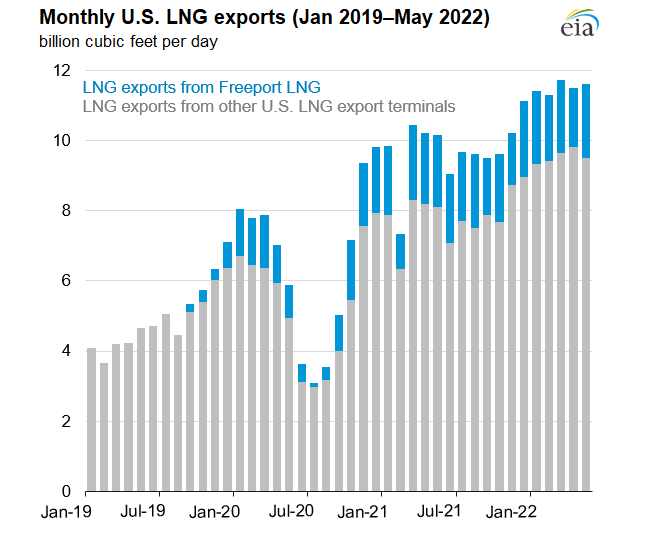
Data source: U.S. Department of Energy, LNG Monthly reports, and EIA estimates for April and May 2022
Note: LNG = liquefied natural gas
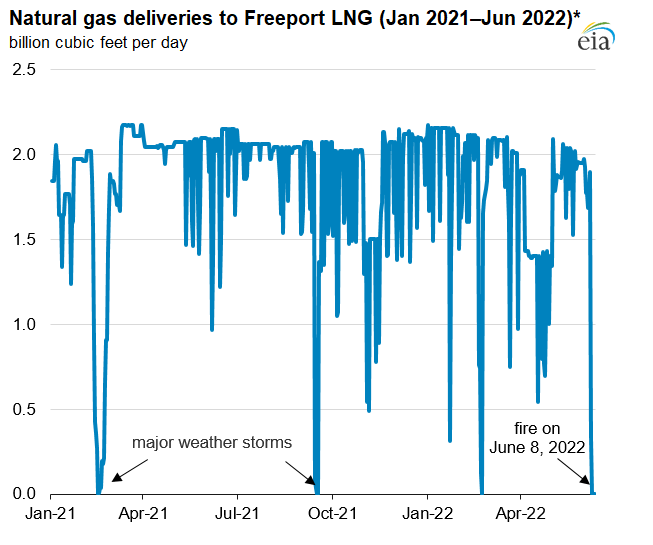
Data source: PointLogic
*Note: Chart includes daily feedgas flows data for January 1, 2021–June 12, 2022
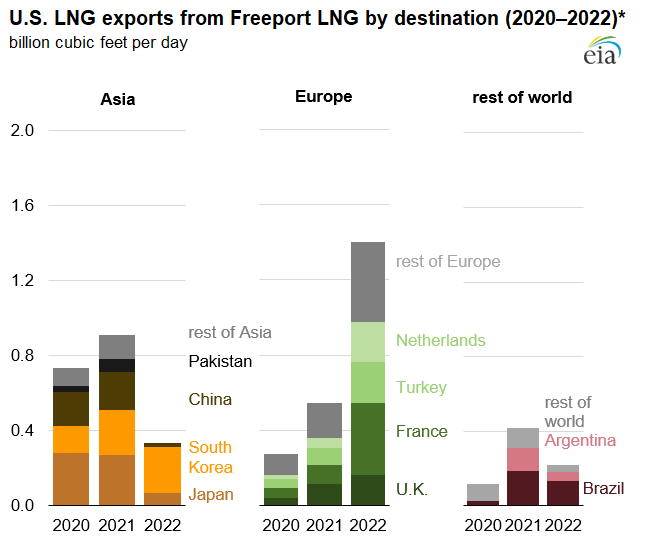
Data source: U.S. Department of Energy, LNG Monthly reports, and EIA estimates for April and May 2022
Note: *Data include annual averages for 2020 and 2021 and a five-month average (January–May) for 2022. LNG = liquefied natural gas.
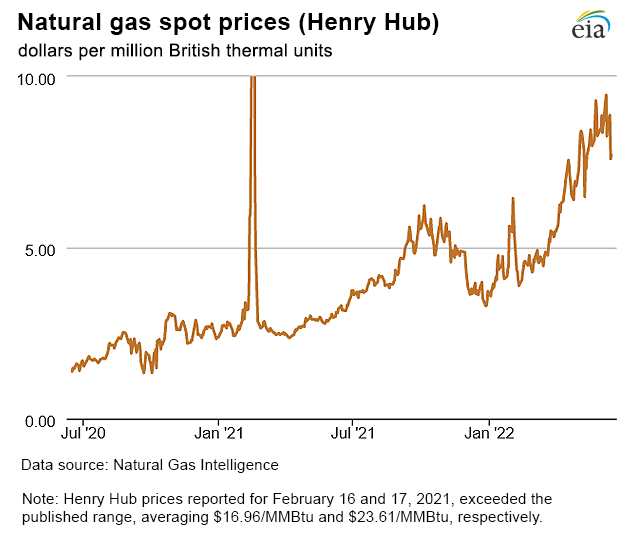
| Spot Prices ($/MMBtu) | Thu, 09-Jun |
Fri, 10-Jun |
Mon, 13-Jun |
Tue, 14-Jun |
Wed, 15-Jun |
|---|---|---|---|---|---|
| Henry Hub |
8.26 |
8.67 |
8.87 |
7.59 |
7.72 |
| New York |
7.34 |
7.61 |
8.10 |
6.77 |
7.33 |
| Chicago |
7.88 |
8.32 |
8.41 |
7.07 |
7.42 |
| Cal. Comp. Avg.* |
8.51 |
8.90 |
8.85 |
7.71 |
7.66 |
| Futures ($/MMBtu) | |||||
| July contract | 8.963 |
8.850 |
8.609 |
7.189 |
7.420 |
| August contract |
8.978 |
8.867 |
8.619 |
7.180 |
7.406 |
| Data source: Natural Gas Intelligence and CME Group as compiled by Bloomberg, L.P. *Avg. of NGI's reported prices for: Malin, PG&E Citygate, and Southern California Border Avg. |
|||||
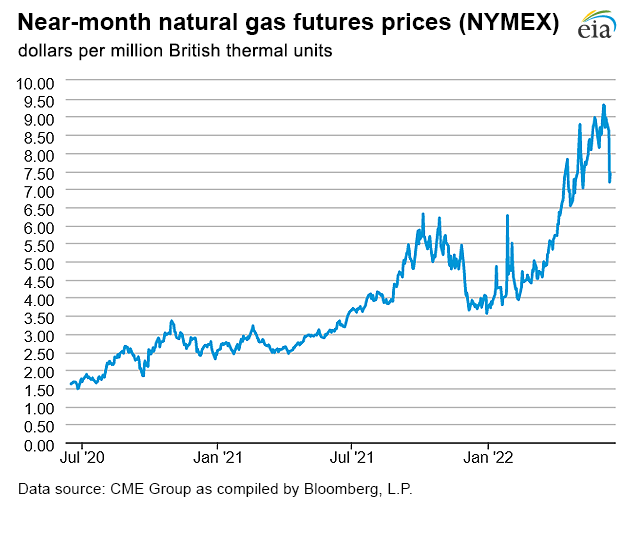
| U.S. natural gas supply - Gas Week: (6/9/22 - 6/15/22) | |||
|---|---|---|---|
Average daily values (billion cubic feet) |
|||
this week |
last week |
last year |
|
| Marketed production | 107.6 |
107.5 |
105.0 |
| Dry production | 95.5 |
95.5 |
93.0 |
| Net Canada imports | 6.1 |
5.3 |
4.9 |
| LNG pipeline deliveries | 0.1 |
0.1 |
0.1 |
| Total supply | 101.7 |
100.8 |
97.9 |
|
Data source: PointLogic | |||
| U.S. natural gas consumption - Gas Week: (6/9/22 - 6/15/22) | |||
|---|---|---|---|
Average daily values (billion cubic feet) |
|||
this week |
last week |
last year |
|
| U.S. consumption | 67.8 |
62.5 |
67.5 |
| Power | 38.1 |
32.4 |
37.4 |
| Industrial | 21.1 |
21.4 |
21.0 |
| Residential/commercial | 8.6 |
8.6 |
9.1 |
| Mexico exports | 5.6 |
5.6 |
6.6 |
| Pipeline fuel use/losses | 6.5 |
6.3 |
6.3 |
| LNG pipeline receipts | 10.7 |
12.5 |
9.4 |
| Total demand | 90.6 |
86.8 |
89.7 |
|
Data source: PointLogic | |||
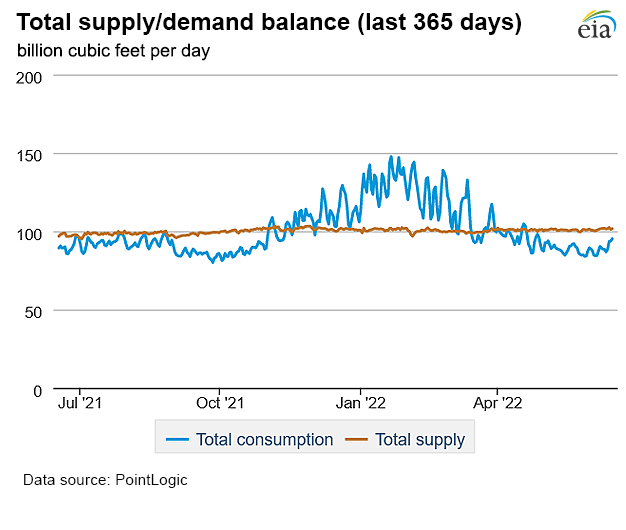
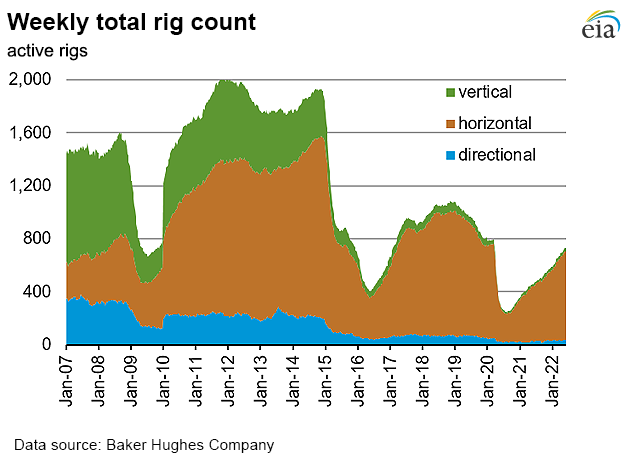
| Rigs | |||
|---|---|---|---|
Tue, June 07, 2022 |
Change from |
||
last week |
last year |
||
| Oil rigs | 580 |
1.0% |
58.9% |
| Natural gas rigs | 151 |
0.0% |
57.3% |
| Note: Excludes any miscellaneous rigs | |||
| Rig numbers by type | |||
|---|---|---|---|
Tue, June 07, 2022 |
Change from |
||
last week |
last year |
||
| Vertical | 27 |
8.0% |
58.8% |
| Horizontal | 668 |
0.3% |
59.0% |
| Directional | 38 |
5.6% |
58.3% |
| Data source: Baker Hughes Company | |||
| Working gas in underground storage | ||||
|---|---|---|---|---|
Stocks billion cubic feet (Bcf) |
||||
| Region | 2022-06-10 |
2022-06-03 |
change |
|
| East | 407 |
376 R |
31 |
|
| Midwest | 482 |
454 R |
28 |
|
| Mountain | 122 |
118 |
4 |
|
| Pacific | 221 |
211 R |
10 |
|
| South Central | 863 |
843 |
20 |
|
| Total | 2,095 |
2,003 R |
92 |
|
|
Data source: U.S. Energy Information Administration Form EIA-912, Weekly Underground Natural Gas Storage Report R=Revised. Working gas stocks were revised to reflect resubmissions of data during the three-week period from May 20, 2022, to June 3, 2022. The reported revisions caused the stocks for June 03, 2022, to change from 1,999 Bcf to 2,003 Bcf, and working gas stocks for the week ending May 27, 2022, changed from 1,902 to 1,901 Bcf. As a result, the implied net change between the weeks ending May 27 and June 03 changed from 97 Bcf to 102 Bcf. The reported revisions for the week ending May 20, 2022, changed working natural gas stocks from 1,819 Bcf to 1,812 Bcf. | ||||
| Working gas in underground storage | |||||
|---|---|---|---|---|---|
Historical comparisons |
|||||
Year ago (6/10/21) |
5-year average (2017-2021) |
||||
| Region | Stocks (Bcf) |
% change |
Stocks (Bcf) |
% change |
|
| East | 459 |
-11.3 |
474 |
-14.1 |
|
| Midwest | 567 |
-15.0 |
550 |
-12.4 |
|
| Mountain | 164 |
-25.6 |
147 |
-17.0 |
|
| Pacific | 242 |
-8.7 |
255 |
-13.3 |
|
| South Central | 993 |
-13.1 |
992 |
-13.0 |
|
| Total | 2,425 |
-13.6 |
2,418 |
-13.4 |
|
| Data source: U.S. Energy Information Administration Form EIA-912, Weekly Underground Natural Gas Storage Report | |||||
| Temperature – heating & cooling degree days (week ending Jun 09) | ||||||||
|---|---|---|---|---|---|---|---|---|
HDDs |
CDDs |
|||||||
| Region | Current total |
Deviation from normal |
Deviation from last year |
Current total |
Deviation from normal |
Deviation from last year |
||
| New England | 15 |
-9 |
12 |
8 |
1 |
-49 |
||
| Middle Atlantic | 7 |
-10 |
6 |
15 |
-2 |
-51 |
||
| E N Central | 20 |
0 |
19 |
11 |
-15 |
-54 |
||
| W N Central | 19 |
1 |
19 |
24 |
-10 |
-50 |
||
| South Atlantic | 0 |
-5 |
0 |
68 |
5 |
-22 |
||
| E S Central | 1 |
-3 |
1 |
64 |
7 |
0 |
||
| W S Central | 0 |
0 |
0 |
102 |
14 |
16 |
||
| Mountain | 15 |
-16 |
11 |
51 |
10 |
-11 |
||
| Pacific | 8 |
-14 |
-11 |
18 |
1 |
3 |
||
| United States | 11 |
-6 |
6 |
40 |
0 |
-25 |
||
|
Data source: National Oceanic and Atmospheric Administration Note: HDDs=heating degree days; CDDs=cooling degree days | ||||||||
Average temperature (°F)
7-day mean ending Jun 09, 2022
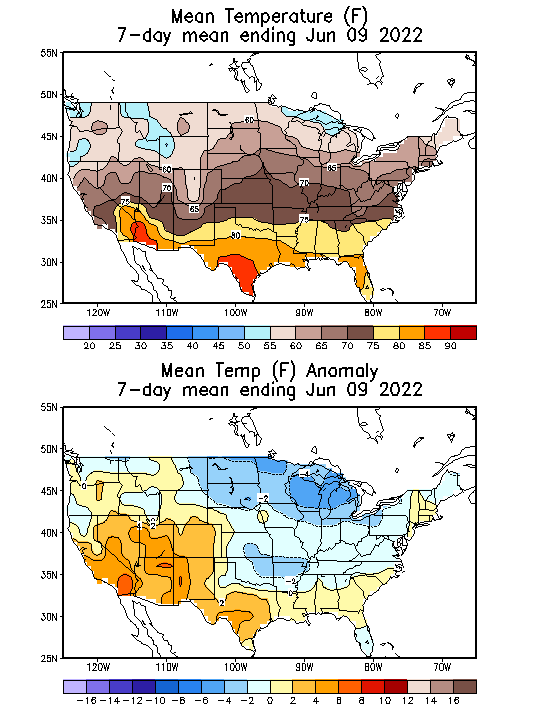
Data source: National Oceanic and Atmospheric Administration
Deviation between average and normal temperature (°F)
7-day mean ending Jun 09, 2022

Data source: National Oceanic and Atmospheric Administration

